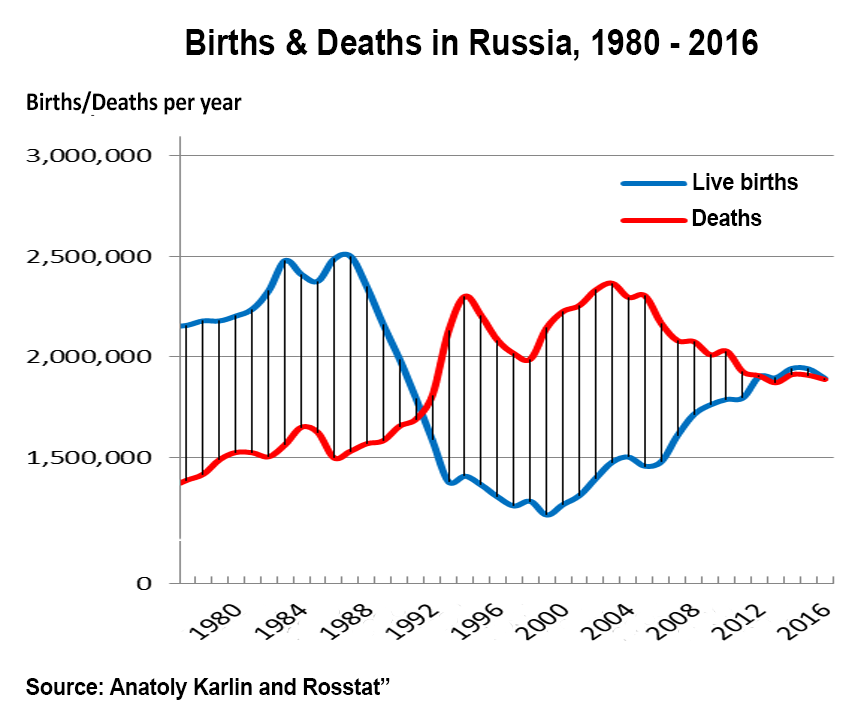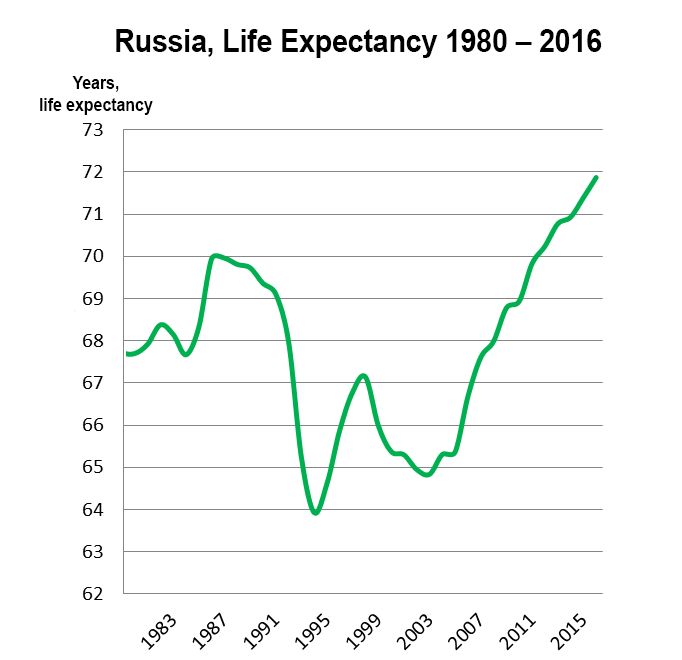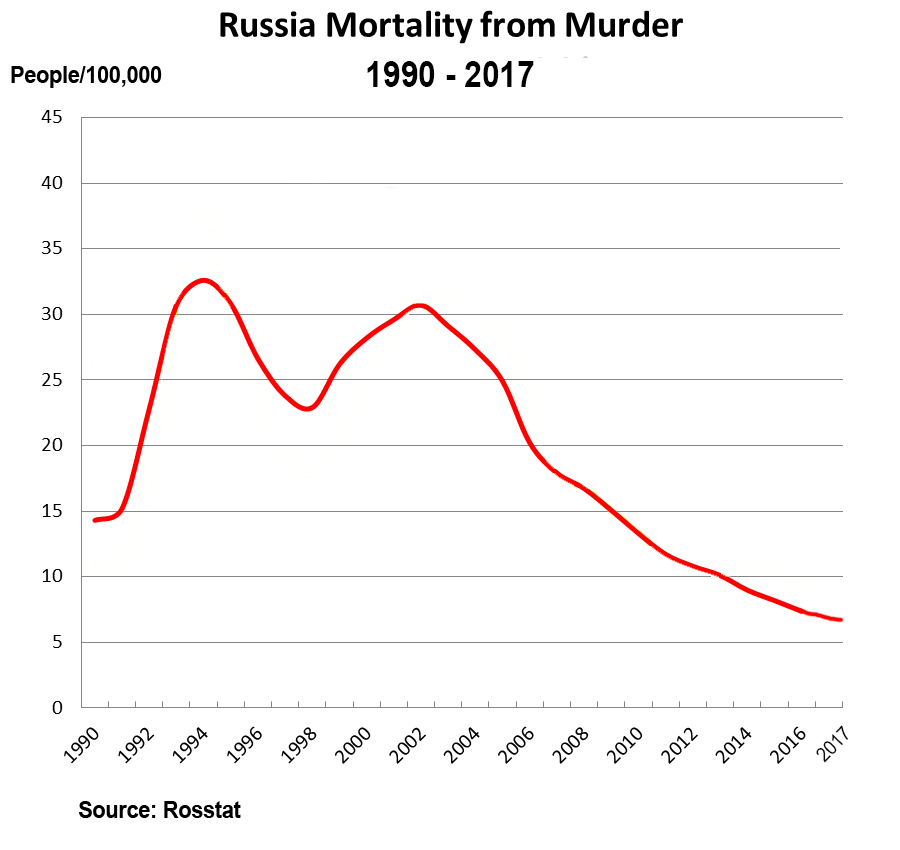The reason I don’t write much about Russia’s demographics nowadays is that there isn’t much point to it.
Up until the early 2010s, the Western media was brimming with misinformation about the subject – what we now call #fakenews – so refuting it was both profitable and easy. Incredibly easy. You didn’t really have to do anything much more complicated than taking a few minutes to browse through Russia’s national statistics database, but apparently that was beyond the capabilities of most Russia journalists.
However, by now a critical number of Western pundits have apparently acquainted themselves with at least the Wikipedia article on Russia’s demographics. In the longterm, reality wins out, and so with a lag time of about a decade, references to Russia’s “plummeting population” and “sixth wave of emigration” have steadily petered out (the last major holdouts of Russia demographic doomerism was Barack Obama in this 2014 interview with The Economist, and Michael Rubin for Commentary in 2015,).
We can now finally say that the “Dying Bear” meme has fulfilled lived up to its own name.
***
Anyhow, preliminary demographic results for 2016 are in.
Births remained marginally ahead of deaths, both at around 12.9/1,000 people, though the usual ~300,000 annual net immigrants (almost half of them from Ukraine) will ensure that overall population growth remains decidedly positive.
Births decreased by 2.6%. The full impact of the small 1990s cohort is now being felt, so this was always inevitable. Deaths also declined by 1.2%, despite the ongoing aging of the population. This pretty much completes what I termed The Russian Hexagon, the successor to the so-called “Russian Cross” in the early 1990s when the births and deaths graphs intersected; in the past decade, birth and death rates once again converged, but from the opposite direction, forming a sort of hexagon.
The Total Fertility Rate seems to have stabilized at around 1.75 children per woman (inevitable question: How much without Muslims/ethnic minorities? Approximately 0.1 children less, based on completed fertility data from the 2010 Census).
This makes sense. As I pointed out almost a decade ago, Russian fertility preferences are similar to those of Scandinavians and the Anglosphere (~2.5 children per woman), and higher than that of Visegrad/The Med (~2.1 children) or the Teutonic world (1.7 children), so convergence to at least this level was always on the cards as soon as some semblance of economic stability and predictability was restored.
As I pointed out, this makes Russia’s fertility rates reasonably respectable by European standards; they are only noticeably higher in France, Ireland, the UK, and Sweden.
Life expectancy is now close to 72 years, which is the highest it has ever been in Russia’s history.
One way of looking at this is that mortality trends in Russia are basically tracking improvements in the ex-Soviet Baltics (and the City of Moscow) with a lag of ten years, so there is good reason to expect this trend will continue.
This is primarily linked to the big reduction in vodka bingeing during the past decade, which depressed Russian life expectancy by about a decade relative to what it “should be” based on its GDP per capita and healthcare system. This “alcoholization” began to soar from around 1965, and peaked in the 1990s and early 2000s. According to calculations by the demographer Alexander Nemtsov, something like a third of Russian mortality around 2005 could be attributed to it.
Blast from the Past
Incidentally, back in 2008, I created a demographic model for Russia, which enabled me to accurately predict a resumption in both total (2010) and natural (2013) population growth to the exact year.
In the scenario where TFR is set to a constant 1.75 children per woman, the “Medium” scenario of mortality improvements (which has best tracked Russia’s life expectancy trends to date), and about 300,000 annual immigrants, it predicted the following:
Medium (TFR=1.75 from 2010) The population grows from 2010, rising from 142mn to 148mn in 2025 and 156mn in 2050. The death rate troughs at 10.8 in 2034, before zooming in to 11.5 by 2050. The birth rate peaks at 13.6 by 2014, before plummeting to 9.7 in 2033, before recovering to 11.9 in 2046 and again falling, although less rapidly than before.
How does this stack up against reality? The birth rate reached a multi-year plateau at 13.3 children per woman during 2012-2015, when the decline in the numbers of women of childbearing age were exactly offset by rising total fertility rates. The mortality rate fell steadily throughout this period, just as predicted, though it is marginally higher as of 2016 (12.9/1,000) than in the Medium variant (12.6/1,000).
Overall, this is pretty close, and suggests that the model is fundamentally sound and thus so are its future population projections.
Of course it has to be adjusted upwards by 2.3 million to take into account Crimea, and any further (re)gatherings of rightful Russian clay.
As alcohol abuse fell, so did all of the other components of mortality, especially those most strongly associated with it, i.e. deaths from external causes:
… which includes homicides, suicides, deaths from transport accidents (despite soaring vehicle ownership), and, self-referentially, deaths from alcohol poisoning.
Part of this reduction was due to cultural change, including the realities of life under capitalism (if you turn up to work drunk, you can be fired, unlike under socialism), part of it was due to economics (more diversity of choice), and part of it was thanks to specific Kremlin policies, such as steady increases in the excise tax on alcohol and restrictions on alcohol advertising.
Finally, the abortion rate continues to quietly decline. The ratio of abortions to births is now down to 40%, down from well more than 100% during the era from the post-Stalin legalization of abortion to the 1990s. This is still about 2-3x higher than in most of Western Europe and the US, but Russia is longer the absolute outlier it once was.
Just like the trends with fertility and mortality, this too can be considered a return to “demographic normality” after the Soviet aberration.
One important point: Conservative talking points to the contrary, there is no hard evidence that high abortion rates actually decrease fertility. Low abortion rates are good though for general health reasons and (depending on your religious views) for ethical ones but they have very little to do with demographic health per se.
Even though it completely bans abortions, Poland has one of Europe’s lowest fertility rates. For some reason Mark Steyn never did dwell on that…




 PapaDragon
PapaDragon




